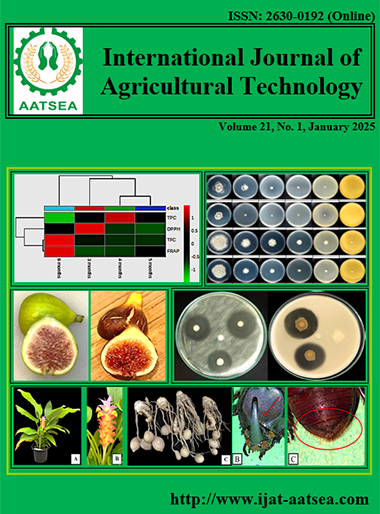Attack intensity and effectiveness pheromone on Oryctes rhinoceros L. in oil palm, Seluma district, Bengkulu.
Main Article Content
Abstract
Oil palm production continues to increase as the area of oil palm plantations increases. Seluma is one of the oil palm production centers in Bengkulu, which is located in the wet tropical region directly bordering the Indian Ocean. One of the main pests on oil palm plants is Oryctes rhinoceros, this pest can cause attacks on immature and mature plants. The use of ferotrap can control O. rhinoceros beetles. However, information regarding O. rhinoceros attacks oil palm has not been reported in Bengkulu. The results showed that the percentage of attacks against the beetle O. rhinoceros was highest in oil palm plantations in Tanjung Seluai Village was 10.53% with an attack intensity was 12.33%, then in Riak Siabun Village the percentage of attacks was 3.09% with an attack intensity was 4.67 % and on oil palm plantations at PT. Sandabi Indah Lestari had no attacks. The lowest average population of O. rhinoceros beetles was 4.67 individuals/ha/2 months in Tanjung Seluai Village, and 7 individuals/ha/2 months in PT. Sandabi Indah Lestari and the highest was 7.67 individuals /ha/2 months in Riak Siabun Village.
Article Details

This work is licensed under a Creative Commons Attribution-NonCommercial-NoDerivatives 4.0 International License.
References
Alouw, J. C. (2007). Pheromones and their use in identifying the coconut beetle pest Oryctes rhinoceros (Coleoptera: Scarabaeidae). Palma Bulletin, 32:12-21.
Apriyaldi, R. (2015). Analysis of the intensity of attacks by the Oryctes rhinoceros on oil palm at PTPN V Sei. Galuh, Kampar Regency. Riau.
Cumber, R. A. (1957). Ecological studies of the rhinoceros beetle Oryctes rhinoceros (L.) in Western Samoa. Technical Papers South Pacific Commission, 6:1-32.
Directorate General of Plantations. (2020). The strategic role of Indonesian palm oil in 2016-2020. Retrieved from http://www.ditjenbun.deptan.go.id.
Fauzana, H. and Ustadi. (2020). Growth of larvae Oryctes rhinoceros L. on various growing media for plants in the Arecaceae family. Indonesian Journal of Entomology, 17:89-96.
Fauzi, Y., Yustina, E., Iman, S. and Rudi, H. (2012). Palm Oil. Penebar Swadaya. Jakarta.
Ginting, M. S., Febrianto, E. B. and Pratama, G. A. (2022). The effect of fruit-trap height on the control of Oryctes rhinoceros in immature plants of oil palm (Elaeis guineensis Jacq.). Agriland, 10:64-67.
Gunarwan, R. (2022). Don't be trivial with horn beetles, they can make your palm oil look like this. Elaeis. co. News Thursday, 13 October 2022. Retrieved from http://www.elaeis.co/berita/baca/jangan-sepele-pada-kumbang-tanduk-bisa-bikin-sawit-jadi-begini
Hadi, M. H., Tarwotjo, U. and Rahadian, R. (2009). Entomology Insect Biology. Graha Ilmu, Yogyakarta.
Handayani, W. F., Jasmi. and Safitri, E. (2014). Population Density of Oryctes rhinoceros. (Coleoptera: Scarabaeidae) on Oil Palm Plants in Kanagarian Surantih, Sutera District, Pesisir Selatan Regency. (Thesis). Department of Biology Education, Faculty of Teacher Training and Education, PGRI College of Education. West Sumatra.
Handoko, J., Fauzana, H. and Sutikno, A. (2017). Population and intensity of attacks by Oryctes rhinoceros on immature oil palm (Elaeis guineensis Jacq.) plants. Faperta UNRI, 4:1-6.
Hendarjanti, H. and Nawangsari, L. N. (2022). Building sustainability business industry palm oil 4.0 through green human resources management, green innovation, and approach green commitment.business and entrepreneurial Review, 22:19-34.
Herman, J. H., Laoh. And Salbiah, D. (2012). Test the height level of pheromone traps to control the horn Beetle Oryctes rhinoceros (Coleoptera: Scarabaeidae) in Oil Palm plants. (Thesis). Faculty of Agriculture, Riau University. Riau. [Indonesian].
Luhukay, R., Sahetapy, B. and Umasangadji, A. (2017). Test the effectiveness of several types of traps against Oryctes rhinoceros L. (Coleoptera; Scarabaeidae). Journal of Agricultural Cultivation, 13:30-35.
Lukman, M. and Alamudin, F. (2018). The intensity of attacks by Oryctes rhinoceros on immature oil palm plants at PT. Barito Putera Plantation. Polytechnic Plantation Plant Cultivation Journal, 4:11-15.
Ministry of Agriculture (2020). Agricultural Statistics. Ministry of Agriculture of the Republic of Indonesia. Jakarta.
Moore, J. A. T, Quitugua, R., Bassler, P. and Campbell, R. (2015). Coconut rhinoceros beetles (Coleoptera: Scarabaeidae) develop in arboreal breeding sites in Guam. Florida Entomologist, 98:1012-1014.
Morin, J. P., Rochat, D., Malosse, C., Lettere, M., de Chenon, R. D., Wibwo, H. and Descoins, C. Le. (1996). Ethyl 4-methyl octanoate, the major component of male pheromone in Oryctes rhinoceros (L.) (Coleoptera: Dynastidae)]. C R Acad Sci III. 1996 Jul, 319:595-602. PMID: 9011322.
Muliani, S., Ridwan, A. and Saputra, H. J. (2017). The level of attack of several types of pests on oil palm (Elaeis guineensis Jacq.) plantations at PT Widya Unggul Lestari, Mamuju Regency. Agroplantae Journal, 6:29-33.
Prok, T. P., Tairas, R. W., Kaligis, J. B. and Lengkong, E. F. (2019). Monitoring rhinoceros beetle pests (Oryctes rhinoceros L.) on coconut plants (Cocos nucifera L.) using pheromones in Mapanget District, Manado City. Cocos, 11:1-8.
Pujiastuti, Y., Setiawan, J. and Arinafri. (2010). Estimation of population development of Oryctes rhinoceros L. (Coleoptera: Scarabaeidae) in oil palm plantations (Elaeis guineensis Jacq.). JRL, 6:199-205.
Pujiastuti, Y., Hendrawansyah. and Hendarjanti, H. (2022). Propagation of entomopathogenic bacteria Bacillus thuringiensis in various agricultural waste and its effectivity against Oryctes rhinoceros (Coleoptera: Scarabaeidae). IOP Conference Series: Earth and Environmental Science, 995 012054. DOI:10.1088/1755-1315/995/1/012054.
Sahetapy, B., Masauna, E. D. and Lunhukay, R. (2018). Test the effectiveness of pheromone traps against the pest Oryctes rhinoceros L. and the intensity of damage to coconut plants in Latuhalat Village, Nusaniwe District, Ambon Island. Agricultural Journal, 29:19-25.
Santi, D. S. and Sumaryo, B. (2008). The effect of pheromone trap color on the catch of Oryctes rhinoceros imago in oil palm plantations. Indonesian Journal of Plant Protection, 14:76-79.
Siahaan. (2014). Research on long-distance agricultural extension training and its impact on improving the quality of life of farmers in Ogan Komering Ilir (OKI) Regency, South Sumatra. Research Report. Bogor Agricultural Institute, Bogor.
Widyanto, H., Saputra, S. and Suryati. (2014). Control of horn beetle pests (Oryctes rhinoceros Linn.) using pheromone traps on oil palm plants (Elaeis guineensis Jacq.) in the peatlands of Riau Province. Proceedings of the National Seminar on Sustainable Management of Degraded Peatlands to Mitigate GHG Emissions and Increase Economic Value. Jakarta. 18-19 August 2014. [Indonesian].


